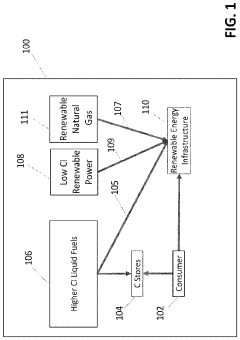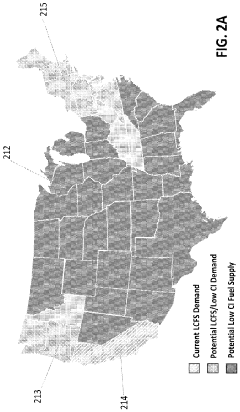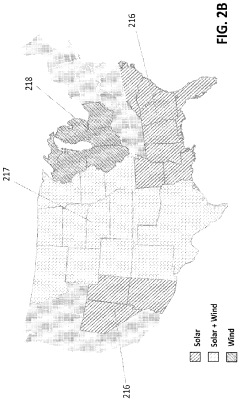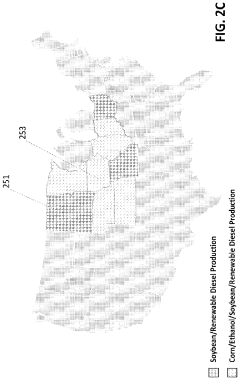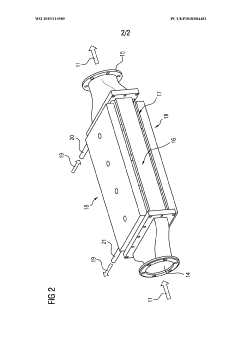Mild hybrid contributions to achieving low-carbon transportation goals
AUG 18, 20259 MIN READ
Generate Your Research Report Instantly with AI Agent
Patsnap Eureka helps you evaluate technical feasibility & market potential.
Mild Hybrid Evolution
Mild hybrid technology has undergone significant evolution since its inception, marking key milestones in the automotive industry's journey towards low-carbon transportation. The development of mild hybrid systems can be traced back to the early 2000s when automakers began exploring ways to improve fuel efficiency and reduce emissions without compromising vehicle performance.
In the initial stages, mild hybrid systems were relatively simple, primarily focusing on start-stop functionality and limited regenerative braking. These early systems, often referred to as micro hybrids, provided modest fuel savings but laid the groundwork for more advanced technologies.
The next phase of evolution saw the introduction of more sophisticated mild hybrid systems, incorporating belt-driven starter generators (BSG) or integrated starter generators (ISG). These systems allowed for improved energy recovery during deceleration and provided additional torque assistance during acceleration, further enhancing fuel efficiency and performance.
As battery technology advanced, mild hybrid systems began to incorporate higher voltage architectures, typically moving from 12V to 48V systems. This shift enabled more powerful electric motors and increased energy storage capacity, leading to greater fuel savings and improved performance. The 48V systems also allowed for the electrification of auxiliary components, such as air conditioning compressors and power steering pumps, further reducing the load on the internal combustion engine.
Recent developments in mild hybrid technology have focused on integrating more advanced power electronics and control systems. These improvements have enabled seamless transitions between electric and combustion power, as well as more sophisticated energy management strategies. Some manufacturers have also introduced mild hybrid systems with electric superchargers or turbochargers, further enhancing performance and efficiency.
The latest generation of mild hybrid systems incorporates advanced features such as predictive energy management, which uses GPS and traffic data to optimize the use of electric power. Additionally, some systems now offer limited pure electric driving capabilities for short distances, blurring the line between mild hybrids and full hybrids.
Looking ahead, the evolution of mild hybrid technology is expected to continue, with a focus on further increasing efficiency and reducing emissions. This may include the development of even higher voltage systems, improved energy recovery techniques, and the integration of artificial intelligence for more sophisticated energy management.
In the initial stages, mild hybrid systems were relatively simple, primarily focusing on start-stop functionality and limited regenerative braking. These early systems, often referred to as micro hybrids, provided modest fuel savings but laid the groundwork for more advanced technologies.
The next phase of evolution saw the introduction of more sophisticated mild hybrid systems, incorporating belt-driven starter generators (BSG) or integrated starter generators (ISG). These systems allowed for improved energy recovery during deceleration and provided additional torque assistance during acceleration, further enhancing fuel efficiency and performance.
As battery technology advanced, mild hybrid systems began to incorporate higher voltage architectures, typically moving from 12V to 48V systems. This shift enabled more powerful electric motors and increased energy storage capacity, leading to greater fuel savings and improved performance. The 48V systems also allowed for the electrification of auxiliary components, such as air conditioning compressors and power steering pumps, further reducing the load on the internal combustion engine.
Recent developments in mild hybrid technology have focused on integrating more advanced power electronics and control systems. These improvements have enabled seamless transitions between electric and combustion power, as well as more sophisticated energy management strategies. Some manufacturers have also introduced mild hybrid systems with electric superchargers or turbochargers, further enhancing performance and efficiency.
The latest generation of mild hybrid systems incorporates advanced features such as predictive energy management, which uses GPS and traffic data to optimize the use of electric power. Additionally, some systems now offer limited pure electric driving capabilities for short distances, blurring the line between mild hybrids and full hybrids.
Looking ahead, the evolution of mild hybrid technology is expected to continue, with a focus on further increasing efficiency and reducing emissions. This may include the development of even higher voltage systems, improved energy recovery techniques, and the integration of artificial intelligence for more sophisticated energy management.
Market Demand Analysis
The market demand for mild hybrid technologies in the transportation sector has been steadily increasing as governments and consumers alike prioritize low-carbon solutions. This growth is driven by stringent emissions regulations, rising fuel costs, and increasing environmental awareness among consumers. The global mild hybrid vehicle market is expected to expand significantly in the coming years, with a compound annual growth rate (CAGR) projected to exceed 10% through 2026.
Several factors contribute to the rising demand for mild hybrid systems. Firstly, these systems offer a cost-effective compromise between conventional internal combustion engines and full hybrid or electric vehicles. They provide improved fuel efficiency and reduced emissions without the high costs associated with more advanced electrification technologies. This makes mild hybrids an attractive option for both manufacturers and consumers looking to balance performance, affordability, and environmental impact.
The passenger car segment dominates the mild hybrid market, with SUVs and sedans seeing the highest adoption rates. However, there is growing interest in applying mild hybrid technologies to light commercial vehicles and even heavy-duty trucks, as fleet operators seek to reduce their carbon footprint and operating costs. This expansion into new vehicle categories is expected to further drive market growth in the coming years.
Geographically, Europe leads the mild hybrid market due to strict CO2 emissions standards and government incentives for low-emission vehicles. Asia-Pacific, particularly China and Japan, is also experiencing rapid growth in mild hybrid adoption. North America, while initially slower to embrace the technology, is now seeing increased demand as automakers expand their mild hybrid offerings to meet fuel efficiency targets.
Consumer preferences are shifting towards more fuel-efficient and environmentally friendly vehicles, but many are not yet ready to fully transition to battery electric vehicles due to concerns about range, charging infrastructure, and higher upfront costs. Mild hybrids offer a familiar driving experience with improved efficiency, making them an appealing stepping stone in the transition to low-carbon transportation.
The market demand for mild hybrid technologies is also influenced by the broader trend towards vehicle electrification and the push for sustainable mobility solutions. As cities implement low-emission zones and countries set ambitious targets for reducing transportation-related emissions, mild hybrids are positioned as a practical near-term solution to help achieve these goals while the infrastructure for full electrification continues to develop.
Several factors contribute to the rising demand for mild hybrid systems. Firstly, these systems offer a cost-effective compromise between conventional internal combustion engines and full hybrid or electric vehicles. They provide improved fuel efficiency and reduced emissions without the high costs associated with more advanced electrification technologies. This makes mild hybrids an attractive option for both manufacturers and consumers looking to balance performance, affordability, and environmental impact.
The passenger car segment dominates the mild hybrid market, with SUVs and sedans seeing the highest adoption rates. However, there is growing interest in applying mild hybrid technologies to light commercial vehicles and even heavy-duty trucks, as fleet operators seek to reduce their carbon footprint and operating costs. This expansion into new vehicle categories is expected to further drive market growth in the coming years.
Geographically, Europe leads the mild hybrid market due to strict CO2 emissions standards and government incentives for low-emission vehicles. Asia-Pacific, particularly China and Japan, is also experiencing rapid growth in mild hybrid adoption. North America, while initially slower to embrace the technology, is now seeing increased demand as automakers expand their mild hybrid offerings to meet fuel efficiency targets.
Consumer preferences are shifting towards more fuel-efficient and environmentally friendly vehicles, but many are not yet ready to fully transition to battery electric vehicles due to concerns about range, charging infrastructure, and higher upfront costs. Mild hybrids offer a familiar driving experience with improved efficiency, making them an appealing stepping stone in the transition to low-carbon transportation.
The market demand for mild hybrid technologies is also influenced by the broader trend towards vehicle electrification and the push for sustainable mobility solutions. As cities implement low-emission zones and countries set ambitious targets for reducing transportation-related emissions, mild hybrids are positioned as a practical near-term solution to help achieve these goals while the infrastructure for full electrification continues to develop.
Technical Challenges
Mild hybrid systems face several technical challenges in their contribution to achieving low-carbon transportation goals. One of the primary obstacles is the limited electric-only range of these vehicles. Unlike full hybrids or plug-in hybrids, mild hybrids typically cannot operate solely on electric power for extended periods, which restricts their ability to significantly reduce emissions in urban environments.
The integration of the electric motor and conventional powertrain components presents another challenge. Engineers must optimize the system to seamlessly switch between electric and combustion power sources, ensuring smooth operation and maximizing fuel efficiency. This requires sophisticated control algorithms and robust hardware that can withstand frequent transitions between power modes.
Battery technology remains a critical constraint for mild hybrid systems. The batteries used in these vehicles must be compact enough to fit within existing vehicle architectures while providing sufficient power and energy density. Balancing these requirements with cost considerations is an ongoing challenge for manufacturers seeking to make mild hybrid technology more widely accessible.
Thermal management is another significant technical hurdle. The frequent cycling between electric and combustion power can generate substantial heat, necessitating advanced cooling systems to maintain optimal performance and longevity of both the electric components and the internal combustion engine.
Weight reduction is crucial for improving the efficiency of mild hybrid vehicles. However, the addition of electric motors, batteries, and associated control systems inherently increases vehicle weight. Engineers must employ innovative materials and design strategies to offset this added mass without compromising safety or performance.
Regenerative braking systems, while beneficial for energy recovery, present their own set of challenges. Designing a system that can effectively capture and store braking energy while providing a natural and responsive braking feel to the driver requires careful calibration and sophisticated control systems.
Cost-effectiveness remains a persistent challenge for mild hybrid technology. While less expensive than full hybrid systems, the additional components still represent a significant cost increase over conventional powertrains. Manufacturers must continue to innovate to reduce production costs and make mild hybrid technology economically viable for mass-market adoption.
Lastly, the limited power output of mild hybrid systems compared to full hybrids or electric vehicles means that their contribution to emissions reduction is more modest. Improving the efficiency and capabilities of these systems without significantly increasing complexity or cost is an ongoing challenge in the pursuit of low-carbon transportation goals.
The integration of the electric motor and conventional powertrain components presents another challenge. Engineers must optimize the system to seamlessly switch between electric and combustion power sources, ensuring smooth operation and maximizing fuel efficiency. This requires sophisticated control algorithms and robust hardware that can withstand frequent transitions between power modes.
Battery technology remains a critical constraint for mild hybrid systems. The batteries used in these vehicles must be compact enough to fit within existing vehicle architectures while providing sufficient power and energy density. Balancing these requirements with cost considerations is an ongoing challenge for manufacturers seeking to make mild hybrid technology more widely accessible.
Thermal management is another significant technical hurdle. The frequent cycling between electric and combustion power can generate substantial heat, necessitating advanced cooling systems to maintain optimal performance and longevity of both the electric components and the internal combustion engine.
Weight reduction is crucial for improving the efficiency of mild hybrid vehicles. However, the addition of electric motors, batteries, and associated control systems inherently increases vehicle weight. Engineers must employ innovative materials and design strategies to offset this added mass without compromising safety or performance.
Regenerative braking systems, while beneficial for energy recovery, present their own set of challenges. Designing a system that can effectively capture and store braking energy while providing a natural and responsive braking feel to the driver requires careful calibration and sophisticated control systems.
Cost-effectiveness remains a persistent challenge for mild hybrid technology. While less expensive than full hybrid systems, the additional components still represent a significant cost increase over conventional powertrains. Manufacturers must continue to innovate to reduce production costs and make mild hybrid technology economically viable for mass-market adoption.
Lastly, the limited power output of mild hybrid systems compared to full hybrids or electric vehicles means that their contribution to emissions reduction is more modest. Improving the efficiency and capabilities of these systems without significantly increasing complexity or cost is an ongoing challenge in the pursuit of low-carbon transportation goals.
Current Solutions
01 Mild hybrid system design for reducing carbon emissions
Mild hybrid technology incorporates an electric motor alongside a conventional internal combustion engine to improve fuel efficiency and reduce carbon emissions. This system allows for engine start-stop functionality, regenerative braking, and electric assist during acceleration, resulting in lower fuel consumption and decreased CO2 emissions.- Mild hybrid system architecture for reducing carbon emissions: Mild hybrid systems integrate electric motors with conventional internal combustion engines to improve fuel efficiency and reduce carbon emissions. These systems typically include components like a starter-generator, battery pack, and power electronics to enable features such as engine start-stop, regenerative braking, and electric assist during acceleration.
- Energy management strategies in mild hybrid vehicles: Advanced energy management strategies are employed in mild hybrid vehicles to optimize the use of electric power and minimize fuel consumption. These strategies may include predictive algorithms, real-time data analysis, and adaptive control systems to balance power distribution between the electric motor and internal combustion engine based on driving conditions and energy demands.
- Regenerative braking systems for energy recovery: Regenerative braking systems in mild hybrid vehicles capture kinetic energy during deceleration and convert it into electrical energy, which is then stored in the battery. This recovered energy can be used to power vehicle systems or assist in acceleration, reducing the load on the internal combustion engine and lowering overall carbon emissions.
- Lightweight materials and aerodynamic design for efficiency: The use of lightweight materials in vehicle construction and aerodynamic design improvements contribute to reducing carbon emissions in mild hybrid vehicles. Advanced materials such as high-strength steel, aluminum alloys, and composites help decrease vehicle weight, while optimized body shapes and active aerodynamic features minimize air resistance, resulting in improved fuel efficiency and lower emissions.
- Emissions monitoring and control systems: Sophisticated emissions monitoring and control systems are integrated into mild hybrid vehicles to ensure optimal performance and compliance with environmental regulations. These systems may include advanced sensors, catalytic converters, and exhaust gas recirculation technologies to minimize harmful emissions and provide real-time data for engine management and emissions reduction strategies.
02 Energy management strategies in mild hybrid vehicles
Advanced energy management strategies are employed in mild hybrid vehicles to optimize the use of electric power and internal combustion engine. These strategies include intelligent power distribution, adaptive control algorithms, and predictive energy management systems, which work together to minimize fuel consumption and reduce overall carbon emissions.Expand Specific Solutions03 Regenerative braking systems for carbon emission reduction
Mild hybrid vehicles utilize regenerative braking systems to recover kinetic energy during deceleration and braking. This recovered energy is stored in the battery and later used to assist the engine, reducing the load on the internal combustion engine and consequently lowering carbon emissions.Expand Specific Solutions04 Integration of mild hybrid technology with existing powertrains
Mild hybrid technology can be integrated into existing vehicle powertrains with minimal modifications. This allows for widespread adoption across various vehicle models, leading to a significant reduction in overall fleet carbon emissions. The integration focuses on optimizing the interaction between the electric motor and the internal combustion engine to maximize efficiency gains.Expand Specific Solutions05 Carbon emission monitoring and reporting in mild hybrid vehicles
Advanced monitoring and reporting systems are implemented in mild hybrid vehicles to track real-time carbon emissions. These systems provide accurate data on fuel consumption, electric power usage, and overall carbon footprint, enabling drivers and fleet managers to optimize vehicle operation for minimal environmental impact.Expand Specific Solutions
Key Industry Players
The mild hybrid technology market for low-carbon transportation is in a growth phase, with increasing adoption across the automotive industry. The market size is expanding rapidly, driven by stringent emissions regulations and consumer demand for fuel-efficient vehicles. Technologically, mild hybrid systems are relatively mature, with major automakers like Hyundai, BYD, and Toyota leading the way. Companies such as BorgWarner and Schaeffler are developing advanced components to enhance system efficiency. While established players dominate, emerging companies like Vitesco Technologies are also making significant contributions. The competitive landscape is characterized by continuous innovation and strategic partnerships to improve performance and reduce costs, indicating a dynamic and evolving market.
Hyundai Motor Co., Ltd.
Technical Solution: Hyundai's mild hybrid system, often referred to as 48V technology, combines a small electric motor with a traditional internal combustion engine. The system uses a 48-volt lithium-ion battery to power the electric motor, which assists the engine during acceleration and enables the engine to shut off when the vehicle is coasting or stopped. Hyundai's mild hybrid technology can reduce CO2 emissions by up to 11% in real-world driving conditions [3]. The system also features a Belt-Driven Starter Generator (BSG) that allows for quick and smooth engine restarts. Hyundai has been expanding the application of this technology across its model range, including popular models like the Tucson and Santa Fe [4].
Strengths: Cost-effective solution for reducing emissions, easily integrated into existing vehicle platforms. Weaknesses: Limited electric-only operation compared to full hybrids.
BYD Co., Ltd.
Technical Solution: BYD's mild hybrid system, part of their DM (Dual Mode) technology, combines a gasoline engine with an electric motor and a lithium-ion battery. The system allows for pure electric driving at low speeds and provides electric assist during acceleration. BYD's mild hybrid technology can reduce fuel consumption by up to 20% compared to conventional vehicles [5]. The company's unique approach includes the integration of their in-house developed battery technology, which offers higher energy density and longer lifespan. BYD has also developed a sophisticated power management system that optimizes the use of electric and gasoline power based on driving conditions [6].
Strengths: Vertical integration of key components, including batteries, allows for better system optimization. Weaknesses: Limited global market presence compared to some competitors.
Core Technologies
Systems and methods for holistic low carbon intensity fuel and hydrogen production
PatentPendingUS20240126223A1
Innovation
- Implementing systems and methods that integrate renewable energy sources into feedstock procurement, refining, and distribution pathways to reduce carbon emissions, using alternative energy sources like wind, solar, and geothermal power, and renewable feedstocks to lower the carbon intensity of transportation fuels and hydrogen, while allowing for conventional retail outlet access without requiring special vehicles or equipment.
Hybrid system for driving a vehicle
PatentWO2019115585A1
Innovation
- A hybrid system integrating a 48V mild hybrid system, thermoelectric generator, and photovoltaic system, coordinated via a DC/DC converter, to harness exhaust heat and solar energy for additional drive power, optimizing energy use and reducing fuel consumption.
Emissions Regulations
Emissions regulations play a crucial role in shaping the automotive industry's approach to low-carbon transportation. These regulations are designed to limit the amount of greenhouse gases and other pollutants emitted by vehicles, with the ultimate goal of mitigating climate change and improving air quality.
In recent years, governments worldwide have implemented increasingly stringent emissions standards. The European Union, for instance, has set ambitious targets through its Euro 6 and upcoming Euro 7 standards. These regulations impose strict limits on carbon dioxide (CO2) emissions, as well as other pollutants such as nitrogen oxides (NOx) and particulate matter.
Similarly, the United States has established Corporate Average Fuel Economy (CAFE) standards, which require automakers to achieve specific fleet-wide fuel efficiency targets. These standards indirectly regulate emissions by promoting the development of more fuel-efficient vehicles.
China, the world's largest automotive market, has also introduced its own emissions regulations, including the China 6 standard, which is comparable to Euro 6 in terms of stringency. These regulations have significantly influenced the development and adoption of mild hybrid technologies in the Chinese market.
The impact of these regulations on mild hybrid technology has been substantial. Automakers have increasingly turned to mild hybrid systems as a cost-effective solution to meet emissions targets. These systems, which typically incorporate a small electric motor and battery to assist the internal combustion engine, can provide significant improvements in fuel efficiency and emissions reduction without the complexity and cost of full hybrid or electric powertrains.
Mild hybrid technology has proven particularly effective in addressing the challenges posed by real-world driving conditions. Many emissions regulations now include provisions for real-world testing, such as the Worldwide Harmonized Light Vehicles Test Procedure (WLTP) in Europe. Mild hybrids can help vehicles maintain compliance with these more stringent test protocols by reducing emissions during start-stop cycles and providing electric assistance during acceleration.
As emissions regulations continue to evolve, the role of mild hybrid technology in achieving low-carbon transportation goals is likely to grow. Future regulations may focus on lifecycle emissions, including the production and disposal of vehicles and their components. This could further incentivize the development of mild hybrid systems, which offer a balance between emissions reduction and resource efficiency.
In recent years, governments worldwide have implemented increasingly stringent emissions standards. The European Union, for instance, has set ambitious targets through its Euro 6 and upcoming Euro 7 standards. These regulations impose strict limits on carbon dioxide (CO2) emissions, as well as other pollutants such as nitrogen oxides (NOx) and particulate matter.
Similarly, the United States has established Corporate Average Fuel Economy (CAFE) standards, which require automakers to achieve specific fleet-wide fuel efficiency targets. These standards indirectly regulate emissions by promoting the development of more fuel-efficient vehicles.
China, the world's largest automotive market, has also introduced its own emissions regulations, including the China 6 standard, which is comparable to Euro 6 in terms of stringency. These regulations have significantly influenced the development and adoption of mild hybrid technologies in the Chinese market.
The impact of these regulations on mild hybrid technology has been substantial. Automakers have increasingly turned to mild hybrid systems as a cost-effective solution to meet emissions targets. These systems, which typically incorporate a small electric motor and battery to assist the internal combustion engine, can provide significant improvements in fuel efficiency and emissions reduction without the complexity and cost of full hybrid or electric powertrains.
Mild hybrid technology has proven particularly effective in addressing the challenges posed by real-world driving conditions. Many emissions regulations now include provisions for real-world testing, such as the Worldwide Harmonized Light Vehicles Test Procedure (WLTP) in Europe. Mild hybrids can help vehicles maintain compliance with these more stringent test protocols by reducing emissions during start-stop cycles and providing electric assistance during acceleration.
As emissions regulations continue to evolve, the role of mild hybrid technology in achieving low-carbon transportation goals is likely to grow. Future regulations may focus on lifecycle emissions, including the production and disposal of vehicles and their components. This could further incentivize the development of mild hybrid systems, which offer a balance between emissions reduction and resource efficiency.
Cost-Benefit Analysis
The cost-benefit analysis of mild hybrid technology in achieving low-carbon transportation goals reveals a complex interplay of economic, environmental, and social factors. From an economic perspective, mild hybrid systems offer a relatively low-cost entry point into electrification compared to full hybrid or battery electric vehicles. The initial investment for manufacturers to integrate mild hybrid technology into existing vehicle platforms is significantly lower than developing entirely new electric powertrains.
For consumers, the incremental cost of mild hybrid vehicles over conventional internal combustion engine (ICE) vehicles is typically modest, often ranging from $500 to $2,000. This price premium can be offset by fuel savings over the vehicle's lifetime, especially in urban driving conditions where mild hybrid systems excel at reducing fuel consumption during frequent starts and stops. Studies have shown that mild hybrid technology can improve fuel efficiency by 10-15% in city driving scenarios.
However, the cost-benefit ratio varies depending on factors such as fuel prices, driving patterns, and vehicle usage. In regions with low fuel costs, the payback period for the additional upfront cost may be longer, potentially reducing consumer adoption rates. Conversely, in areas with high fuel prices or stringent emissions regulations, the economic benefits become more pronounced.
From an environmental standpoint, mild hybrid technology contributes to reducing greenhouse gas emissions and improving air quality, particularly in urban environments. The reduction in fuel consumption directly translates to lower CO2 emissions, typically in the range of 10-20 grams per kilometer. While this reduction is modest compared to full electric vehicles, the widespread adoption of mild hybrid technology across a large fleet of vehicles can lead to significant cumulative emissions reductions.
The social benefits of mild hybrid technology include improved urban air quality, reduced noise pollution during low-speed operation, and potential health benefits associated with decreased emissions. These factors contribute to enhanced quality of life in urban areas and align with broader societal goals of sustainable transportation.
However, it is important to note that mild hybrid technology represents an incremental step towards low-carbon transportation rather than a comprehensive solution. Critics argue that the resources invested in mild hybrid development could potentially be redirected towards more transformative technologies like full electric vehicles. Additionally, the long-term cost-benefit analysis must consider the potential for mild hybrid technology to become obsolete as stricter emissions standards are implemented and battery technology improves.
In conclusion, the cost-benefit analysis of mild hybrid technology in the context of low-carbon transportation goals suggests a positive but nuanced contribution. While it offers a cost-effective and readily implementable solution for reducing emissions in the short to medium term, its long-term viability and sufficiency in meeting increasingly stringent environmental targets remain subjects of ongoing debate and analysis.
For consumers, the incremental cost of mild hybrid vehicles over conventional internal combustion engine (ICE) vehicles is typically modest, often ranging from $500 to $2,000. This price premium can be offset by fuel savings over the vehicle's lifetime, especially in urban driving conditions where mild hybrid systems excel at reducing fuel consumption during frequent starts and stops. Studies have shown that mild hybrid technology can improve fuel efficiency by 10-15% in city driving scenarios.
However, the cost-benefit ratio varies depending on factors such as fuel prices, driving patterns, and vehicle usage. In regions with low fuel costs, the payback period for the additional upfront cost may be longer, potentially reducing consumer adoption rates. Conversely, in areas with high fuel prices or stringent emissions regulations, the economic benefits become more pronounced.
From an environmental standpoint, mild hybrid technology contributes to reducing greenhouse gas emissions and improving air quality, particularly in urban environments. The reduction in fuel consumption directly translates to lower CO2 emissions, typically in the range of 10-20 grams per kilometer. While this reduction is modest compared to full electric vehicles, the widespread adoption of mild hybrid technology across a large fleet of vehicles can lead to significant cumulative emissions reductions.
The social benefits of mild hybrid technology include improved urban air quality, reduced noise pollution during low-speed operation, and potential health benefits associated with decreased emissions. These factors contribute to enhanced quality of life in urban areas and align with broader societal goals of sustainable transportation.
However, it is important to note that mild hybrid technology represents an incremental step towards low-carbon transportation rather than a comprehensive solution. Critics argue that the resources invested in mild hybrid development could potentially be redirected towards more transformative technologies like full electric vehicles. Additionally, the long-term cost-benefit analysis must consider the potential for mild hybrid technology to become obsolete as stricter emissions standards are implemented and battery technology improves.
In conclusion, the cost-benefit analysis of mild hybrid technology in the context of low-carbon transportation goals suggests a positive but nuanced contribution. While it offers a cost-effective and readily implementable solution for reducing emissions in the short to medium term, its long-term viability and sufficiency in meeting increasingly stringent environmental targets remain subjects of ongoing debate and analysis.
Unlock deeper insights with Patsnap Eureka Quick Research — get a full tech report to explore trends and direct your research. Try now!
Generate Your Research Report Instantly with AI Agent
Supercharge your innovation with Patsnap Eureka AI Agent Platform!
